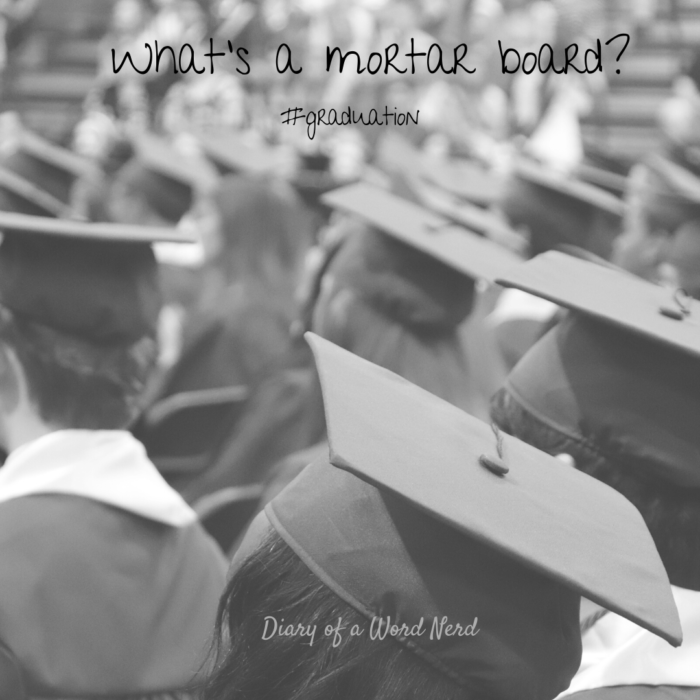What did I say in last week’s Mother’s Day post? That May caused chaos in the daily planner? As I write this, I am also baking, packing, and checking the reminders list for things our family will need as we celebrate my daughter’s college graduation. It’s an exciting time. And I hope I’ve purchased enough breakfast food.
I’ve already attended one graduation ceremony, and as a school board member, I will attend four more, not including my daughter’s. You know what that means? LOTS of “Pomp & Circumstance,” and lots of looking at tassels bobbing around on square shaped hats that always seem to be sliding off graduate’s heads.
For graduation season 2024, I am recycling (so sustainable of me!) a piece from 2018 that I did on several graduation traditions, including the funny hat (aka “mortar board”) and “Pomp & Circumstance.” Read on and learn!

My son pulled his wrinkled graduation gown out of its packaging and asked, “Why do I have to wear a dress?” Good question. And while we are at it, why do graduates have to wear a square shaped hat called a mortar board that does not look attractive at any angle, nor does it stay on, despite the use of several bobby pins? And what’s up with “Pomp and Circumstance,” the march played at nearly every graduation ceremony?
The Gown
Turns out the “dress”, or rather the graduation gown, has history dating back to the 12th and 13th centuries. Back in the Medieval Period, students and teachers wore clerical clothing (clothing worn by church officials) because the church had great influence over academics, and many teachers were priests, monks, or clerics. The “academic regalia”, like the clothing of church officials, distinguished scholars from laypeople. It is also believed that academics wore long robes with hoods to keep warm in the unheated buildings where they studied.
Scholars wore robes all the time, and Oxford and Cambridge were the first schools to require special graduation attire. In the 14th century, these British schools forbade “excessive apparel” at institutions of learning and required long gowns during ceremonies to promote unity among academics. By the 1800s, different colored robes were introduced to signify different areas of study.
The European style of academic regalia came to America with the colonists. After the Civil War, American students wore caps and gowns only at graduation ceremonies to symbolize recognition and achievement. Until the 1950s, robes were usually gray, but during the 50s, students adopted different colors to represent their schools or areas of study. In modern times, high school robes are usually school colors, while bachelor and master degree graduates wear black robes, and doctoral graduates wear a colored robe representing their field of study. Administrators, officials, and professors often wear a robe slightly different in style from the robes students wear.
The Mortar Board
The history of the mortar board, a skull cap with a large square board on top that looks like the board masons use to hold plaster, is also intimately tied to the church. The shape of the cap has changed since the Medieval Period, based on changes to hat styles worn by priests and clerics. The odd shaped cap has shown both the association of academics to the church, and, in later years, the separation of academics from religion.
Historians believe the square shaped hat was adopted for academic regalia for one of several reasons: the square shape symbolizes a book; the square shape symbolizes a quad at Oxford; the shape represents the board of a master workman. The tassels are worn on the cap as a sign of distinction, and although there are no official rules on where the tassel should be worn, most schools hold to the tradition of degree candidates starting the ceremony with the tassel on their right and flipping it over to the left during commencement.
After participating in many graduations, I can tell you that darn cap shifts around like a skate board and the tassel never stays put. To my son and graduates everywhere I say, do the best you can, at least you don’t have to wear it that often.
Pomp and Circumstance
Besides the classic cap and gown, graduation ceremonies are almost always characterized by Pomp and Circumstance, a somber march composed by the British musician Sir Edward Elgar in 1901. His march, named after a line from Shakespeare’s play Othello (“Pride, pomp, and circumstance of glorious war!”) wasn’t originally used for graduation ceremonies but rather for the coronation of King Edward VII.
Pomp and Circumstance became associated with graduations in 1905 when it was played as Elger received an honorary doctorate from Yale University. After that, prestigious schools like Princeton, Columbia, and the University of Chicago started using it during graduation ceremonies, and other schools followed suit. The term Pomp and Circumstance has come to mean “splendid celebration with ceremony and fuss”.
Fuss indeed. There are senior pictures and cap and gown pictures and wear the t-shirt for the college you will be attending pictures. There are announcements and parties and, as I realized when I walked into Walmart yesterday, cakes. (Yikes! Do I need to order one?) There are Baccalaureate Services, awards assemblies and the big one: graduation itself. And this sentimental mother could cry when she thinks of the momentous shift about to occur in her child’s life, but for now, I’m holding strong, proud of the accomplishments achieved and excited for opportunities ahead. The goal is to launch, and the “dress”, cap, and “Pomp”, all remind me- we have reached the goal.
The tears will come when I have to hug my son, say goodbye, and turn and walk out of a dorm room. But until then, I’ll focus on the happy.
Congratulations to graduates of every school and subject this May.
Sources:
Academic Regalia Tams and Caps
Graduation Cap and Gown History
Graduation Rites Have Ancient History
MIT: Regalia History
Time History
What are your thoughts on “the dress” and mortar board?
Thanks for getting nerdy with me!




Wow! It feels like ages ago that the oldest was graduating HIGH SCHOOL :0
I personally used my mortar board as a clutch and it did not touch my head for the entire graduation ceremony — less bobby pins, more time for pomp.